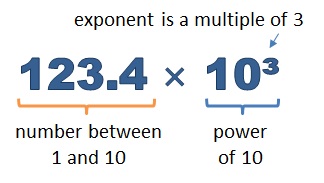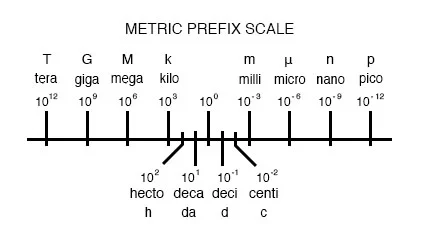Effortlessly manage complex numbers with an engineering notation converter, a crucial tool for anyone working with large or small numerical values in scientific and engineering fields. Engineering notation simplifies complex numbers, making calculations more manageable and communication more precise.
The number below is written in engineering notation. It is said as “123.4 times 10 to the 3”.

Table of Contents
What is Engineering Notation?
Engineering notation is a version of scientific notation where the exponent of ten is a multiple of three. This alignment with metric prefixes (kilo, mega, micro, etc.) makes it particularly useful in technical disciplines.
Key Characteristics
- Exponent Multiples of Three: Aligns numbers with standard metric prefixes.
- Simplifies Representation: Makes very large or very small numbers easier to read and interpret.
- Widely Used in Technical Fields: Essential for accurate calculations and data communication.
Example:
- Standard Form: 0.00047
- Scientific Notation: 4.7 × 10<sup>−4</sup>
- Engineering Notation: 470 × 10<sup>−6</sup>
The Importance of Engineering Notation
Using engineering notation streamlines complex calculations and enhances clarity when dealing with diverse scales of measurement.
Benefits
- Improved Clarity: Aligns numbers with familiar metric units.
- Enhanced Precision: Reduces the risk of errors in calculations.
- Efficiency in Communication: Facilitates better understanding among professionals.
- Standardization: Promotes consistency across technical documents and communications.

How to Write Numbers in Engineering Notation
Converting a number into engineering notation involves adjusting the decimal point and modifying the exponent accordingly.
Steps for Conversion
- Identify the Original Number: Determine the number you wish to convert.
- Move the Decimal Point: Adjust it so the coefficient is between 1 and 1000.
- Adjust the Exponent: Ensure the exponent is a multiple of three.
- Apply Metric Prefixes: Use appropriate units for better understanding.
Detailed Example
- Original Number: 123,456,000
- Step 1: Identify the number.
- Step 2: Move decimal to get a coefficient between 1 and 1000: 123.456
- Step 3: Count the decimal moves (8 places) and adjust exponent to be a multiple of three: 10<sup>6</sup>
- Engineering Notation: 123.456 × 10<sup>6</sup>
- With Metric Prefix: 123.456 Megas (if applicable to the unit)
Using an Engineering Notation Converter
While manual conversion is educational, using an engineering notation converter ensures accuracy and saves time, especially when dealing with complex numbers.
Common Mistakes and How to Avoid Them
Understanding common pitfalls can enhance accuracy in using engineering notation.
Mistake 1: Incorrect Exponent Adjustment
- Issue: Not adjusting the exponent to a multiple of three.
- Solution: Always ensure the exponent after conversion is divisible by three.
Mistake 2: Misaligning Metric Prefixes
- Issue: Using the wrong metric prefix for a given exponent.
- Solution: Refer to a metric prefix chart to match exponents with correct prefixes.
Mistake 3: Rounding Errors
- Issue: Losing significant figures due to improper rounding.
- Solution: Maintain the required number of significant figures throughout calculations.
Applications of Engineering Notation
Engineering notation is prevalent in various fields where measurements span a wide range.
Electronics
- Resistors and Capacitors: Values often in kiloohms (kΩ) or microfarads (µF).
- Signal Frequencies: Measured in megahertz (MHz) or gigahertz (GHz).
Physics
- Wavelengths: From nanometers (nm) to kilometers (km).
- Forces: Expressed in newtons with appropriate prefixes.
Engineering Design
- Mechanical Components: Dimensions ranging from micrometers (µm) to meters (m).
- Civil Engineering: Large-scale measurements in kilometers.
Environmental Science
- Pollutant Concentrations: Parts per million (ppm) or parts per billion (ppb).
Tips for Mastery
- Practice Regularly: Convert various numbers to build proficiency.
- Use Visual Aids: Charts and tables help associate exponents with prefixes.
- Leverage Tools: Utilize calculators and software that support engineering notation.
- Stay Updated: Keep abreast of industry standards and practices.
Here’s a video tutorial that walks through engineering notation examples:
Advanced Concepts
For those looking to deepen their understanding, consider exploring the following topics.
Complex Numbers in Engineering Notation
- Imaginary Components: Representing complex numbers with real and imaginary parts.
- Application: Used extensively in electrical engineering for impedance calculations.
Engineering Notation in Computing
- Data Storage: Bytes, kilobytes (KB), megabytes (MB), gigabytes (GB).
- Processing Speeds: From kilohertz (kHz) to terahertz (THz).
Scientific Calculations
- Astronomical Measurements: Distances in light-years or parsecs.
- Quantum Physics: Planck’s constant and particle sizes.
Converting Between Notations
- Scientific to Engineering Notation: Adjusting exponents to match engineering standards.
- SI Units and Beyond: Understanding and applying non-standard units.
Resources for Further Learning
- Textbooks:
- Engineering Mathematics by K.A. Stroud
- Advanced Engineering Mathematics by Erwin Kreyszig
- Online Tutorials:
- Educational Videos:
- Engineering Notation Made Easy on YouTube
- Metric Prefixes and Engineering Notation lectures
- Software Tools:
- MATLAB
- Wolfram Alpha
Conclusion
Engineering notation is a fundamental tool that simplifies working with extremely large or small numbers. By mastering this notation, professionals and students can enhance their calculation efficiency and improve communication in technical fields. Whether you’re an engineer, scientist, or student, understanding and utilizing engineering notation is essential for success in your field.

